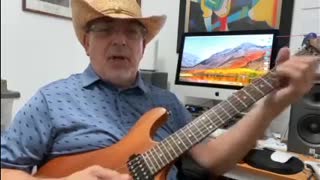Premium Only Content
![Blues Rhythm Guitar Lessons for Beginners [12 Bar Texas-Style]](https://1a-1791.com/video/s8/1/a/G/9/h/aG9hc.qR4e-small-Blues-Rhythm-Guitar-Lessons.jpg)
Blues Rhythm Guitar Lessons for Beginners [12 Bar Texas-Style]
This Blues Rhythm Guitar Lessons for Beginners video by Paluzzi Guitar will show how to play a 12- Bar Texas-Style Rhythm.
Blues Guitar Lessons for Beginners Playlist
https://www.youtube.com/watch?v=OVNcyOJHg_0&list=PLOKVJibwUTbr_Fq9kCp3mRfkhsP0f5jvf
Lesson Plan [Texas Blues]
https://12a8507c-516b-2ae5-5b6d-45935a0049c2.filesusr.com/ugd/6781a9_63bdb4ebc6944f6d89466d9144937b0f.pdf
Blues Rhythm Guitar Lessons for Beginners [12 Bar Texas-Style]
0:00 Lesson Preview
1:11 Lesson Intro
1:31 Intro Riff
2:17 Bar 1
3:15 Bars 1-4
3:50 Bars 5-8
5:11 Bars 1-8 (slow review)
6:10 Bars 9-12
8:02 Bars 9-12 (slow review)
8:40 Verse 1 (Bars 1-12 slow review)
9:57 Verse 2 Ending
10:57 False Ending/Outro
12:00 Lesson Review
How to Play Texas Blues Rhythm on Guitar
A Texas Blues rhythm for guitar features strummed chords played in combination with a walking bass line. This Blues Guitar Lessons for beginners video features a 12 bar Texas Blues rhythm played in the Key of 'E' Blues. This Texas blues rhythm progression will feature new variations added to the standard twelve-bar format from previous lessons, including rhythm changes, chord substitutions, and a false ending.
12 Bar Texas Blues Rhythm Progression
The Intro of the 12-bar Texas Blues rhythm progression is a standard Blues riff in ‘E’ that ends with a strummed ‘E’ chord. For this Texas Blues rhythm tempo, ‘count’ the Intro as: ‘1-2-3 - 1-2-3 - 1-2-3 - 1... ’ with the last sustained ‘1' count being the strummed ‘E’ chord. After the strummed ‘E’ chord, the slash marks (‘ / ’) represent an extra ‘lead-in’ count (‘ ...2 - 3 - 4...’) that can be counted aloud, silently, or tapped in order to establish a tempo to begin the twelve-bar Texas Blues rhythm progression.
How to Strum Texas Blues Rhythm on Guitar
The actual Texas Blues rhythm begins on Bar 1. Initially, count each bar/section of this 12-bar Blues progression as: ‘1 - 2... 1 - 2 - 3 - 1 - 2 - 3...’, with the first ‘1-2' counts being the strummed ‘E’ chord followed by a six-note bass line riff. As an alternative, each bar can be counted in ‘fours’ (‘1 - 2 - 3 - 4 - 1 - 2 - 3 - 4'). Regardless of the count used, the key to playing a Texas Blues rhythm bass line on guitar is to capture a rhythm like that of a cowboy riding a slow, galloping horse.
Bars 5-6 of the Texas Blues rhythm 12-bar progression features an ‘A7' chord. The same Texas-style strum pattern continues, with the only difference being the same six-note bass line simply shifts up one string to be played. Bars 7-8 return back to ‘E’ with the same Texas Blues rhythm played in Bars 1-4.
For Bars 9-10 of this Texas Blues rhythm progression in 'E', a rhythm change occurs, referred to here as a ‘Walk in the Park’ rhythm due to its easy-going strum pattern (‘down-up... down-up-up-down’).
For Bar 11, return back to the initial Texas rhythm in ‘E’. Bar 12 features a turnaround that ends Verse 1 and ‘leads-in’ to Verse 2. The same ‘B7' chord shape in Bar 9 is used for the turnaround, using all downstrokes to change the tempo (‘1-2-3-1-2-3-1-2-3-1-2-3') and to ‘rev-up’ into Verse 2.
In Verse 2, the Ending section replaces the turnaround. A twelve-bar progression typically ends with a strummed chord at the twelfth bar. Here, the Ending is extended with an added Outro section, making what appears to be the strummed ‘E’ ending actually the ‘false’ ending.
Note the seventh chords (‘A7' and ‘B7’) being used instead of the standard or primary chords (‘A’ and ‘E’) from the Key of ‘E’. This seventh chord substitution is common in many Texas Blues rhythm progressions.
Paluzzi Guitar
The objective of the Paluzzi Guitar series is to help establish a foundation of guitar fundamentals by applying various playing techniques (rhythm, fingerstyle, and soloing) to various styles of music. The more playing styles and techniques a guitarist can learn, the more diverse and self-sufficient a guitarist will become. A self-sufficient guitarist can then teach themselves, communicate with other musicians, and even write their own music once a solid foundation of fundamentals is established.
The Creative Guitarist Method Series was written and designed by Kevin J. Paluzzi of Paluzzi Guitar Instruction in San Diego, CA. For more information on private lessons and books, go to:
There really isn’t any one particular playing style or technique required in order to classify someone as a guitarist. For example, Andres Segovia, the Beatles, and Carlos Santana are all considered legendary performing guitarists, but each has his own particular style or technique (fingerstyle, strumming, and soloing) for playing. The Paluzzi Guitar series of books and videos are designed with a ‘pick and choose’ topic format (songwriting, soloing, etc.) so that once the Guitar Basics are completed, the guitarist can decide to focus on whatever topic they wish to study.
-
![Blues Rhythm Guitar Lessons for Beginners [12 Bar Texas-Style]](https://1a-1791.com/video/s8/1/9/u/8/h/9u8hc.0kob-small-Blues-Rhythm-Guitar-Lessons.jpg) 10:50
10:50
PaluzziGuitar
3 years agoBlues Rhythm Guitar Lessons for Beginners [12 Bar Texas-Style]
462 -
![Blues Rhythm Guitar Lessons for Beginners [12 Bar A Shuffle]](https://1a-1791.com/video/s8/1/I/7/7/h/I77hc.0kob-small-Blues-Rhythm-Guitar-Lessons.jpg) 10:22
10:22
PaluzziGuitar
3 years agoBlues Rhythm Guitar Lessons for Beginners [12 Bar A Shuffle]
457 -
![Blues Rhythm Guitar Lessons for Beginners [Easy Bass Line]](https://1a-1791.com/video/s8/1/j/c/7/h/jc7hc.0kob-small-Blues-Rhythm-Guitar-Lessons.jpg) 10:39
10:39
PaluzziGuitar
3 years agoBlues Rhythm Guitar Lessons for Beginners [Easy Bass Line]
515 -
![Blues Soloing Guitar Lessons for Beginners [Open E Riffs]](https://1a-1791.com/video/s8/1/n/P/2/h/nP2hc.0kob-small-Blues-Soloing-Guitar-Lesson.jpg) 6:42
6:42
PaluzziGuitar
3 years agoBlues Soloing Guitar Lessons for Beginners [Open E Riffs]
679 -
![Blues Guitar Lessons for Beginners [How to Play E Shuffle Rhythm]](https://1a-1791.com/video/s8/1/D/_/X/g/D_Xgc.0kob-small-Blues-Guitar-Lessons-for-Be.jpg) 8:10
8:10
PaluzziGuitar
3 years agoBlues Guitar Lessons for Beginners [How to Play E Shuffle Rhythm]
623 -
 7:46
7:46
gjacobs333
3 years ago $0.13 earnedBeginners Guitar lessons Introduction to "George Jacobs"
1172 -
 1:06:25
1:06:25
Savanah Hernandez
9 hours agoEXPOSED: FBI destroys evidence as NSA’s LGBTQ sex chats get leaked?!
81.9K30 -
 1:59:58
1:59:58
Revenge of the Cis
11 hours agoEpisode 1452: Hindsight
75K13 -
 1:20:35
1:20:35
Awaken With JP
13 hours agoCrenshaw Threatens to Kill Tucker and Other Wild Happenings - LIES Ep 80
133K74 -
 1:32:19
1:32:19
Russell Brand
11 hours agoBREAK BREAD EP. 15 - LECRAE
145K10